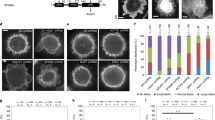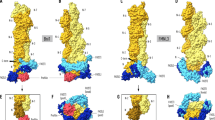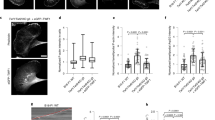Abstract
The actin cytoskeleton is essential for many cellular functions including shape determination, intracellular transport and locomotion. Previous work has identified two factors—the Arp2/3 complex and the formin family of proteins—that nucleate new actin filaments via different mechanisms. Here we show that the Drosophila protein Spire represents a third class of actin nucleation factor. In vitro, Spire nucleates new filaments at a rate that is similar to that of the formin family of proteins but slower than in the activated Arp2/3 complex, and it remains associated with the slow-growing pointed end of the new filament. Spire contains a cluster of four WASP homology 2 (WH2) domains, each of which binds an actin monomer. Maximal nucleation activity requires all four WH2 domains along with an additional actin-binding motif, conserved among Spire proteins. Spire itself is conserved among metazoans and, together with the formin Cappuccino, is required for axis specification in oocytes and embryos, suggesting that multiple actin nucleation factors collaborate to construct essential cytoskeletal structures.
This is a preview of subscription content, access via your institution
Access options
Subscribe to this journal
Receive 51 print issues and online access
$199.00 per year
only $3.90 per issue
Buy this article
- Purchase on Springer Link
- Instant access to full article PDF
Prices may be subject to local taxes which are calculated during checkout





Similar content being viewed by others
References
Manseau, L. J. & Schupbach, T. cappuccino and spire: two unique maternal-effect loci required for both the anteroposterior and dorsoventral patterns of the Drosophila embryo. Genes Dev. 3, 1437–1452 (1989)
Manseau, L., Calley, J. & Phan, H. Profilin is required for posterior patterning of the Drosophila oocyte. Development 122, 2109–2116 (1996)
Pruyne, D. et al. Role of formins in actin assembly: nucleation and barbed-end association. Science 297, 612–615 (2002)
Evangelista, M., Pruyne, D., Amberg, D. C., Boone, C. & Bretscher, A. Formins direct Arp2/3-independent actin filament assembly to polarize cell growth in yeast. Nature Cell Biol. 4, 260–269 (2002)
Otto, I. M. et al. The p150-Spir protein provides a link between c-Jun N-terminal kinase function and actin reorganization. Curr. Biol. 10, 345–348 (2000)
Wellington, A. et al. Spire contains actin binding domains and is related to ascidian posterior end mark-5. Development 126, 5267–5274 (1999)
Paunola, E., Mattila, P. K. & Lappalainen, P. WH2 domain: a small, versatile adapter for actin monomers. FEBS Lett. 513, 92–97 (2002)
Higgs, H. N., Blanchoin, L. & Pollard, T. D. Influence of the C terminus of Wiskott-Aldrich syndrome protein (WASp) and the Arp2/3 complex on actin polymerization. Biochemistry 38, 15212–15222 (1999)
Panchal, S. C., Kaiser, D. A., Torres, E., Pollard, T. D. & Rosen, M. K. A conserved amphipathic helix in WASP/Scar proteins is essential for activation of Arp2/3 complex. Nature Struct. Biol. 10, 591–598 (2003)
Abo, A. Understanding the molecular basis of Wiskott-Aldrich syndrome. Cell. Mol. Life Sci. 54, 1145–1153 (1998)
Devreotes, P. N. & Zigmond, S. H. Chemotaxis in eukaryotic cells: a focus on leukocytes and Dictyostelium. Annu. Rev. Cell Biol. 4, 649–686 (1988)
Blanchoin, L. et al. Direct observation of dendritic actin filament networks nucleated by Arp2/3 complex and WASP/Scar proteins. Nature 404, 1007–1011 (2000)
Mullins, R. D., Heuser, J. A. & Pollard, T. D. The interaction of Arp2/3 complex with actin: nucleation, high affinity pointed end capping, and formation of branching networks of filaments. Proc. Natl Acad. Sci. USA 95, 6181–6186 (1998)
Kovar, D. R., Kuhn, J. R., Tichy, A. L. & Pollard, T. D. The fission yeast cytokinesis formin Cdc12p is a barbed end actin filament capping protein gated by profilin. J. Cell Biol. 161, 875–887 (2003)
Zigmond, S. H. Formin-induced nucleation of actin filaments. Curr. Opin. Cell Biol. 16, 99–105 (2004)
Hertzog, M. et al. The β-thymosin/WH2 domain; structural basis for the switch from inhibition to promotion of actin assembly. Cell 117, 611–623 (2004)
Hertzog, M., Yarmola, E. G., Didry, D., Bubb, M. R. & Carlier, M. F. Control of actin dynamics by proteins made of β-thymosin repeats: the actobindin family. J. Biol. Chem. 277, 14786–14792 (2002)
Dayel, M. J. & Mullins, R. D. Activation of Arp2/3 complex: Addition of the first subunit of the new filament by a WASP protein triggers rapid ATP hydrolysis on Arp2. PLoS Biol. 2, E91 (2004)
Sept, D. & McCammon, J. A. Thermodynamics and kinetics of actin filament nucleation. Biophys. J. 81, 667–674 (2001)
Irobi, E. et al. Structural basis of actin sequestration by thymosin-β4: implications for WH2 proteins. EMBO J. 23, 3599–3608 (2004)
Pollard, T. D. & Borisy, G. G. Cellular motility driven by assembly and disassembly of actin filaments. Cell 112, 453–465 (2003)
Fehrenbacher, K., Huckaba, T., Yang, H. C., Boldogh, I. & Pon, L. Actin comet tails, endosomes and endosymbionts. J. Exp. Biol. 206, 1977–1984 (2003)
Kovar, D. R. & Pollard, T. D. Insertional assembly of actin filament barbed ends in association with formins produces piconewton forces. Proc. Natl Acad. Sci. USA 101, 14725–14730 (2004)
Watanabe, N., Kato, T., Fujita, A., Ishizaki, T. & Narumiya, S. Cooperation between mDia1 and ROCK in Rho-induced actin reorganization. Nature Cell Biol. 1, 136–143 (1999)
Sagot, I., Klee, S. K. & Pellman, D. Yeast formins regulate cell polarity by controlling the assembly of actin cables. Nature Cell Biol. 4, 42–50 (2002)
Pelham, R. J. & Chang, F. Actin dynamics in the contractile ring during cytokinesis in fission yeast. Nature 419, 82–86 (2002)
Schumacher, N., Borawski, J. M., Leberfinger, C. B., Gessler, M. & Kerkhoff, E. Overlapping expression pattern of the actin organizers Spir-1 and formin-2 in the developing mouse nervous system and the adult brain. Gene Expr. Patterns 4, 249–255 (2004)
O'Rourke, D. A. et al. Hepatocyte growth factor induces MAPK-dependent formin IV translocation in renal epithelial cells. J. Am. Soc. Nephrol. 11, 2212–2221 (2000)
Kerkhoff, E. et al. The Spir actin organizers are involved in vesicle transport processes. Curr. Biol. 11, 1963–1968 (2001)
Sonnichsen, B., De Renzis, S., Nielsen, E., Rietdorf, J. & Zerial, M. Distinct membrane domains on endosomes in the recycling pathway visualized by multicolor imaging of Rab4, Rab5, and Rab11. J. Cell Biol. 149, 901–914 (2000)
Jankovics, F., Sinka, R. & Erdelyi, M. An interaction type of genetic screen reveals a role of the Rab11 gene in oskar mRNA localization in the developing Drosophila melanogaster oocyte. Genetics 158, 1177–1188 (2001)
Dollar, G., Struckhoff, E., Michaud, J. & Cohen, R. S. Rab11 polarization of the Drosophila oocyte: a novel link between membrane trafficking, microtubule organization, and oskar mRNA localization and translation. Development 129, 517–526 (2002)
Emmons, S. et al. Cappuccino, a Drosophila maternal effect gene required for polarity of the egg and embryo, is related to the vertebrate limb deformity locus. Genes Dev. 9, 2482–2494 (1995)
Welch, M. D., Rosenblatt, J., Skoble, J., Portnoy, D. A. & Mitchison, T. J. Interaction of human Arp2/3 complex and the Listeria monocytogenes ActA protein in actin filament nucleation. Science 281, 105–108 (1998)
Acknowledgements
This work was supported by grants from the NIH, Pew Charitable Trust and the Sandler Family Supporting Foundation (to R.D.M.). E.K. was supported by the Deutsche Forschungsgemeinschaft and the Wilhelm Sander-Stiftung. We thank C. B. Leberfinger and J. M. Borawski for technical assistance, and members of the Mullins laboratory for technical help and for discussions.
Author information
Authors and Affiliations
Corresponding author
Ethics declarations
Competing interests
The authors declare that they have no competing financial interests.
Supplementary information
Supplementary Notes
This file contains the Supplementary Methods, Supplementary Data, Supplementary Figures S1-9 and Supplementary Table S1. It also includes additional references. (DOC 1925 kb)
Rights and permissions
About this article
Cite this article
Quinlan, M., Heuser, J., Kerkhoff, E. et al. Drosophila Spire is an actin nucleation factor. Nature 433, 382–388 (2005). https://doi.org/10.1038/nature03241
Received:
Accepted:
Issue Date:
DOI: https://doi.org/10.1038/nature03241
This article is cited by
-
Analysis tools for single-monomer measurements of self-assembly processes
Scientific Reports (2022)
-
Spire1 and Myosin Vc promote Ca2+-evoked externalization of von Willebrand factor in endothelial cells
Cellular and Molecular Life Sciences (2022)
-
Phosphorylation of the WH2 domain in yeast Las17/WASP regulates G-actin binding and protein function during endocytosis
Scientific Reports (2021)
-
Role of Actin Cytoskeleton in E-cadherin-Based Cell–Cell Adhesion Assembly and Maintenance
Journal of the Indian Institute of Science (2021)
-
Rab27a co-ordinates actin-dependent transport by controlling organelle-associated motors and track assembly proteins
Nature Communications (2020)
Comments
By submitting a comment you agree to abide by our Terms and Community Guidelines. If you find something abusive or that does not comply with our terms or guidelines please flag it as inappropriate.



